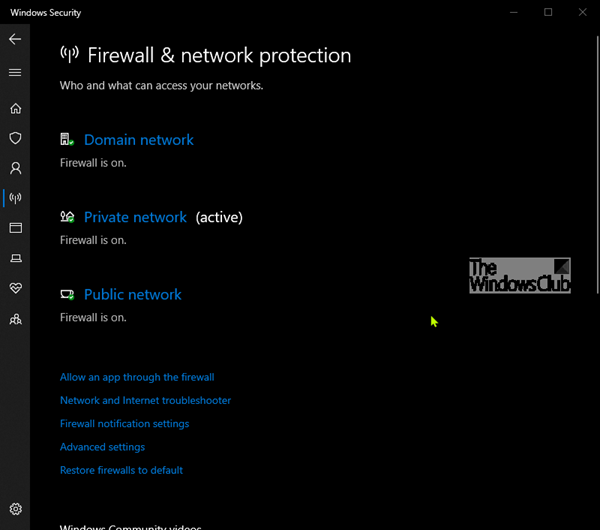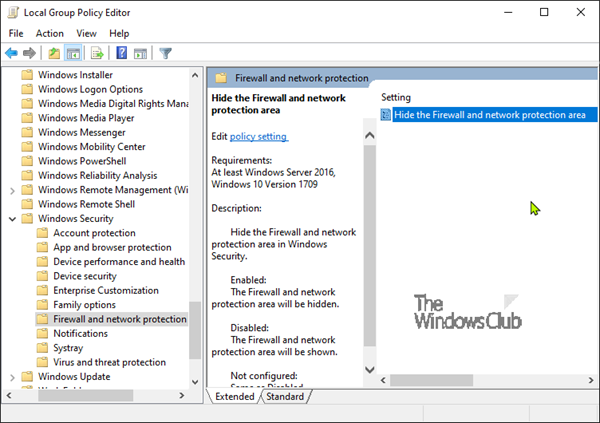In this post, we will explain what is Firewall and Network Protection in Windows 11/10 and how you can disable or hide it. The default built-in Firewall in Windows 11/10 is powerful and helps protect your computer against network threats. We will also show you how you can show or hide the Firewall and Network Protection area in Windows Security from other users.
Firewall and Network Protection in Windows 11/10

The Firewall and Network Protection area in Windows 11/10, is one of the seven areas that protect your device and let you specify how you want your device protected in Windows Defernder Security Center. The seven areas include:
- Virus & threat protection
- Account protection
- Firewall & network protection
- App & browser control
- Device security
- Device performance & health
- Family options.
Here, you can view the status of the Windows Defender Firewall and see what networks your device is connected to. You can also turn on or off and access advanced Windows Defender Firewall options for the following network types:
- Domain (workplace) networks
- Private (discoverable) networks
- Public (non-discoverable) networks.
The Firewall and Network Protection area can be hidden from users. This can be useful if, as an admin, you don’t want them to see or have access to this area. If you choose to hide the Account protection area, it will no longer appear on the home page of the Windows Security Center, and its icon will not be shown on the navigation bar on the side of the app.
Show or Hide Firewall and Network Protection in Windows Security via GPEDIT

- Run gpedit to open the Group Policy Editor
- Navigate to Computer Configuration > Administrative templates > Windows components > Windows Security > Firewall and Network Protection.
- Open the Hide the Firewall and network protection area setting
- Set it to Enabled.
- Click OK.
Hide Firewall and Network Protection in Windows Security via Registry
- Double-click the downloaded Hide-Firewall-and-Network-Protection.reg file to merge it.
- Click Run on the prompt. Click Yes on UAC prompt and OK to allow the merge.
- Restart PC to apply.
- You can now delete the downloaded .reg file.
Show Firewall and Network Protection in Windows Security via Registry
- Double-click the downloaded Show-Firewall-and-Network-Protection.reg file to merge it.
- Click Run on the prompt. Click Yes on UAC prompt, and OK to allow the merge.
- Restart PC to apply.
- You can now delete the downloaded .reg file.
You can click here to download the zipped Registry files from our servers.
How do I turn off Firewall and network protection in Windows 11/10?
To turn off Firewall and network protection in Windows 11 or Windows 10, you need to open the Control Panel first. Then, go to the System and Security section and click on the Windows Defender Firewall option. Click on the Turn Windows Defender Firewall on or off option and click on the Yes button on the UAC prompt. Choose the Turn off Windows Defender Firewall option and click the OK button.
Should I turn on Firewall and network protection?
It is never recommended to turn off the Firewall and network protection. However, if you are using a third-party Firewall application, you can certainly turn off the in-built one. Otherwise, you must turn on Firewall and network protection – no matter which version of Windows you use.
Leave a Reply